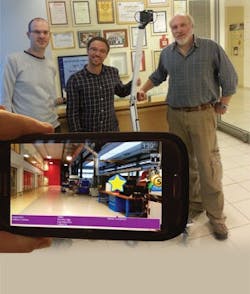MRO Project Aims to Provide Enhanced, High-Value Machinery Support
Scientists from IBM recently revealed a mobile maintenance, repair and operations (MRO) prototype designed to help manufacturers and companies that supply and maintain high-value machinery.
The mobile system, using what IBM describes as a combination of augmented reality and robotics, will help field engineers accurately locate equipment, provide them with critical information and receive real-time visual support from remotely located supervising experts.
IBM says once on site, an engineer can use a smart phone and QR codes to locate and identify an asset and receive maintenance instructions. The smart phone uses augmented reality technology to overlay points of interest over a plan of the site, which can include the location of other engineers, first-aid stations and health and safety apparatus.
If assistance is needed, a remote expert can view the on-site engineer's workspace and provide support with real-time video and audio links using a camera and a small projector mounted at the end of a remotely controlled robotic arm. The remote expert also can project a pointer and valuable information such as free-hand sketches, assembly instructions and CAD images directly onto the workspace or a nearby wall.
"The MRO prototype brings together two innovative IBM technologies, developed in our European research labs in Hursley (U.K.) and Haifa (Israel), into a single solution for our clients," said Richard Lanyon-Hogg, IBM's technical director for the industrial sector. "It offers manufacturers the opportunity to lower their costs, provide just-in-time knowledge transfer and reduce the personal risk to engineers working in difficult environments."
IBM cites studies that have shown that remote support is much more efficient if on-site and remote engineers can share a visual representation of the site workspace and the on-site engineer's actions. To date this has been accomplished, and only in part, by on-site engineers using hand-held cameras, mounted head-gear or specialist glasses. IBM believes the new system provides the supervisor with complete visual independence and a more stable video image; on-site engineers can work with greater freedom or, in the case of those with specialist glasses, freed from the tiring need to re-focus their eyes.
The project is the result of a collaboration with the U.K.'s University of Sheffield Advanced Manufacturing Research Center (AMRC). It is part of the High Value Manufacturing Catapult, a network of leading manufacturing research centers backed by the U.K. government.
The new system is intended to exemplify how a new wave of mobile computing can revolutionize how data from existing back-end systems is increasingly placed in the hands of front-line employees.


